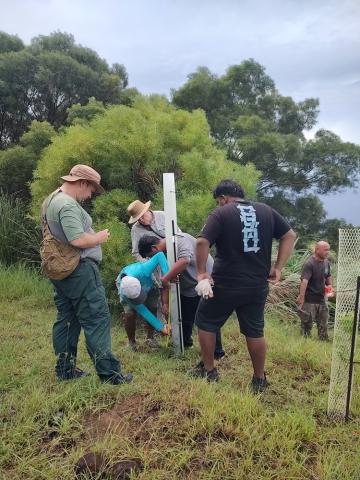In October, we had the privilege of traveling to the Commonwealth of the Northern Mariana Islands (CNMI), the Republic of Palau, and Guam as part of a collaborative effort with the University of Hawaiʻi at Mānoa Extension Forester, Dr. JB Friday, and United States Forest Service Region 5 Tropical Nursery Specialist, Dr. Emily Senegal-Thyroff. This trip was instrumental in building relationships and furthering resilience efforts across the region, focusing on collaboration, resource sharing, and addressing unique regional challenges.
Commonwealth of Northern Mariana Islands

In CNMI, we met with the Northern Marianas College-Cooperative Research Extension and Education Service (NMC-CREES), including Interim Dean, State Program Leader and Scientist, and Extension Agents in the Agriculture Production Program and Nutrition & Health Program, to better understand local communities’ immediate challenges and discuss opportunities for partnership and foster knowledge exchange for mutual benefit across Hawaiʻi and the USAPI. Food and nutritional security were identified as critical areas for partnership and mutual knowledge exchange.
We also met with the Director of the Division of Agriculture in the Department of Lands and Natural Resources and their forestry team, where increasing typhoon intensity and frequency was discussed as a primary threat to their nursery and reforestation programs. Observations on Rota revealed challenges with deer damage to young trees and high mortality rates of seedlings in mesh and tube protections. Collaborative efforts with local foresters involved monitoring outplanting trials designed to improve seedling survival. Agroforestry visits were also included where farms demonstrated the cultivation of kalamansi, betel nut, and native tree species, highlighting the importance of balancing economic and environmental goals.
Palau

Our visit to Palau underscored the importance of local and traditional ecological knowledge and sustainable development in implementing adaptation strategies. Meetings with the Joel Ehrendreich, US Ambassador to the Republic of Palau, National Climate Change Coordinator of the Office of Climate Change, Executive Director of the Ebiil Society, and the Director of the Palau Community College Cooperative Research and Extension highlighted the successes of Palau’s conservation initiatives and the importance of collaboration. We also discussed strategies for integrating these practices with new methods to strengthen both food security and biodiversity resilience. A recurring theme was the challenge of poor soils and the need for effective reforestation strategies, including the use of compost and coconut-based erosion control techniques. Additionally, we learned about efforts to propagate native and culturally important species, such as the reforestation of degraded sites with Calophyllum inophyllum and Terminalia catappa. Conversations with farmers also provided invaluable insights into adaptive planting techniques and the need for capacity-building workshops to address these challenges. Discussions with nursery managers emphasized the need for improved resources, including lighter potting mixes and irrigation systems.
Guam

In Guam, discussions centered on water resource management and invasive species control. We worked with Guam Department of Agriculture, Forestry & Soil Resources Division Director and staff to outplant innovative firebreaks using Scaevola taccada and Hibiscus tiliaceus interplanted with Acacia auriculiformis. These measures aim to reduce fire risks while promoting ecosystem restoration. Visits to community gardens and nurseries further emphasized the role of local agriculture in enhancing food security and community resilience. Meetings with researchers at the University of Guam illuminated the intricate relationships between drought, invasive species, and their cascading effects on agriculture. Collaborative workshops with Guam Forestry staff also explored remote sensing applications for monitoring reforestation efforts and assessing plantation health. Additionally, discussions with Guam’s Department of Agriculture highlighted the importance of increasing capacity for forestry, agriculture, and agroforestry.
Conclusion
Across all these places, there is a shared commitment to addressing complex challenges in the Pacific through collaboration and knowledge exchange. By working together and co-developing strategies, we identified valuable approaches to integrating multiple practices and ways of knowing for resilience in forestry and agriculture. These partnerships emphasize the importance of collective action to support sustainable land management and resource conservation. The insights and connections formed during this trip will inform future initiatives, promoting effective resource management across the Pacific.

